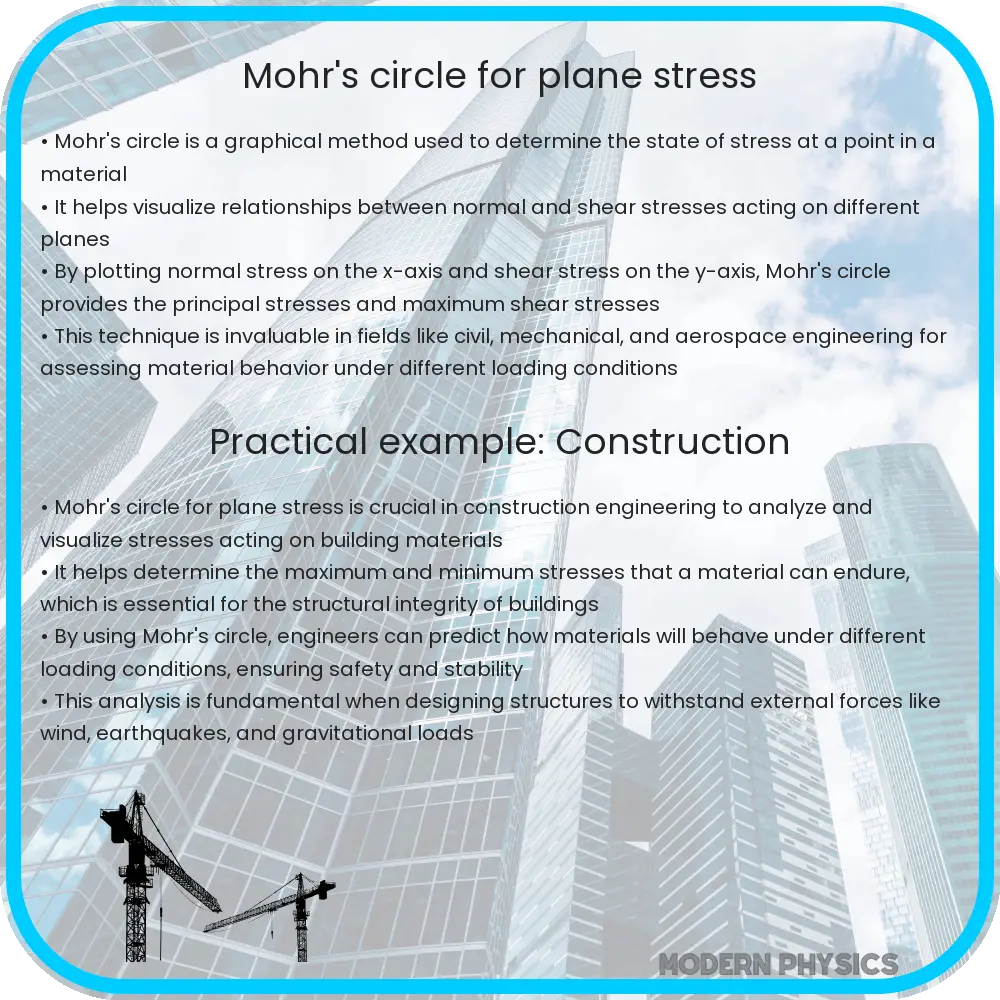Explore Mohr’s Circle for Plane Stress: a guide to understanding and applying principles of stress, strain, and material failure analysis.

Mohr’s Circle for Plane Stress: A Comprehensive Analysis
Understanding stress and strain in materials is crucial for engineers and scientists. One of the most effective tools for analyzing these phenomena in two-dimensional states is Mohr’s Circle for Plane Stress. This graphical method, named after Christian Otto Mohr, offers a clear and concise way to represent and calculate stress components acting on a material element.
Principles of Stress and Strain
Before delving into Mohr’s Circle, it’s essential to understand the basic principles of stress and strain. Stress, denoted as σ, is a measure of internal forces within a material that arise due to external loads. It’s quantified as force per unit area and has units of Pascal (Pa) or Newton per square meter (N/m2). Strain, on the other hand, represents the deformation of the material and is a dimensionless quantity, expressed as the ratio of change in dimension to the original dimension.
What is Plane Stress?
Plane stress is a specific condition where stress is assumed to be uniform across the thickness of a material, such as in thin plates. In this scenario, one of the principal stresses perpendicular to the surface is considered negligible. This simplification leads to a two-dimensional stress state, making it easier to analyze and visualize the stresses using Mohr’s Circle.
Constructing Mohr’s Circle for Plane Stress
To construct Mohr’s Circle for a given plane stress condition, the following steps are followed:
- Identifying Stress Components: Determine the normal (axial) and shear stresses acting on the element. These are typically denoted as σx, σy, and τxy.
- Plotting the Initial Point: On a graph with normal stress (σ) on the horizontal axis and shear stress (τ) on the vertical axis, plot the point with coordinates (σx, τxy).
- Drawing the Circle: Use the average normal stress (σavg = (σx + σy) / 2) as the center and the radius calculated using the formula r = √[(Δσ/2)2 + τxy2] to draw the circle.
This graphical representation provides invaluable insights into the stress state of the material under plane stress conditions. It allows for the determination of principal stresses, maximum shear stresses, and the orientation of the planes on which these stresses act.
In the next section, we will delve deeper into interpreting Mohr’s Circle and applying it to real-world engineering problems, including the analysis of stress transformation and failure criteria.
Interpreting Mohr’s Circle for Engineering Applications
Once Mohr’s Circle is constructed, it becomes a powerful tool for analyzing various stress conditions and predicting material behavior under different loading scenarios. Key aspects of interpretation include:
- Principal Stresses: The maximum and minimum normal stresses, known as principal stresses, are found on the circle’s horizontal axis. The points where the circle intersects this axis represent the principal stresses (σ1, σ2).
- Maximum Shear Stress: The maximum shear stress is represented by the radius of the circle and occurs at an angle of 45° from the principal stresses. It’s crucial in assessing the shear failure of materials.
- Stress Transformation: By rotating the stress element in the Mohr’s Circle, engineers can determine the stresses acting on any inclined plane within the material. This is vital in designing components subjected to complex loading conditions.
Applications of Mohr’s Circle in Material Failure Analysis
Mohr’s Circle is not just a theoretical construct but a practical tool in material science and mechanical engineering. It helps in:
- Predicting Material Failure: By comparing the calculated stresses with the material’s yield or failure criteria, engineers can predict the failure modes, be it shear or tensile failure.
- Design Optimization: Understanding the stress distribution helps in designing more efficient and safer structures and components.
- Stress Concentration Analysis: It aids in identifying areas of high stress concentration, which are potential sites for crack initiation and propagation.
Conclusion
Mohr’s Circle for Plane Stress is an indispensable tool in the field of engineering and material science. Its ability to simplify complex stress analysis into a comprehensible graphical format makes it invaluable for both educational and practical applications. Through its use, engineers can better understand stress distributions, anticipate material behavior under various loading conditions, and design safer, more efficient structures and machines. As materials and engineering challenges evolve, the principles of Mohr’s Circle remain a fundamental part of the engineer’s toolkit, demonstrating the enduring legacy of Christian Otto Mohr’s contribution to the field.
In conclusion, while Mohr’s Circle is a classical method, its relevance and utility in modern engineering cannot be overstated. It bridges the gap between theoretical stress analysis and practical engineering solutions, ensuring that structures and components are designed to withstand the complexities of real-world stresses.
